Chapter1-绪论
- 格式:ppt
- 大小:361.50 KB
- 文档页数:41
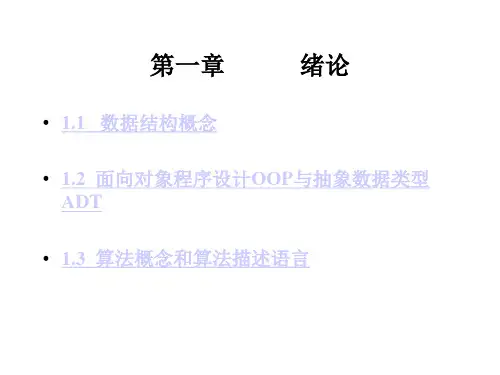
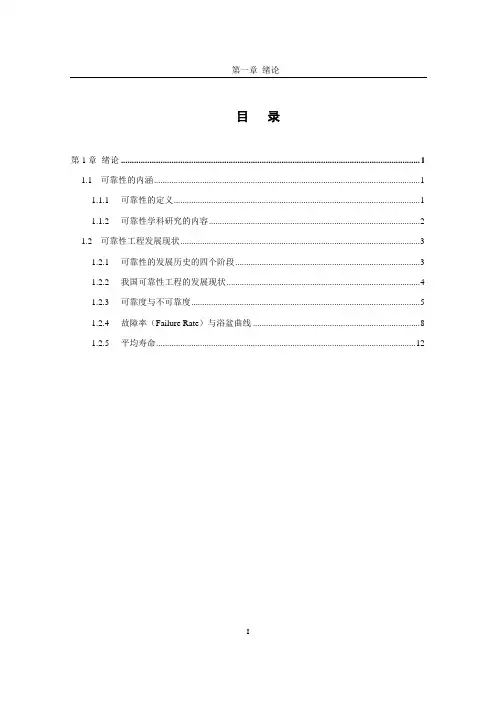
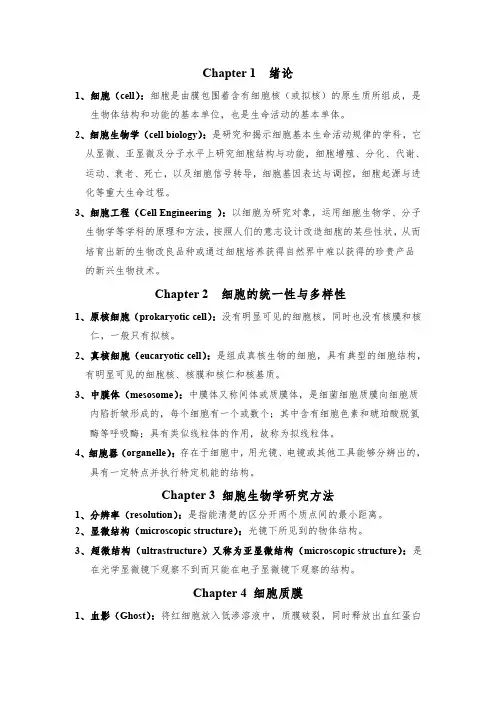
Chapter1绪论1、细胞(cell):细胞是由膜包围着含有细胞核(或拟核)的原生质所组成,是生物体结构和功能的基本单位,也是生命活动的基本单体。
2、细胞生物学(cell biology):是研究和揭示细胞基本生命活动规律的学科,它从显微、亚显微及分子水平上研究细胞结构与功能,细胞增殖、分化、代谢、运动、衰老、死亡,以及细胞信号转导,细胞基因表达与调控,细胞起源与进化等重大生命过程。
3、细胞工程(Cell Engineering):以细胞为研究对象,运用细胞生物学、分子生物学等学科的原理和方法,按照人们的意志设计改造细胞的某些性状,从而培育出新的生物改良品种或通过细胞培养获得自然界中难以获得的珍贵产品的新兴生物技术。
Chapter2细胞的统一性与多样性1、原核细胞(prokaryotic cell):没有明显可见的细胞核,同时也没有核膜和核仁,一般只有拟核。
2、真核细胞(eucaryotic cell):是组成真核生物的细胞,具有典型的细胞结构,有明显可见的细胞核、核膜和核仁和核基质。
3、中膜体(mesosome):中膜体又称间体或质膜体,是细菌细胞质膜向细胞质内陷折皱形成的,每个细胞有一个或数个;其中含有细胞色素和琥珀酸脱氢酶等呼吸酶;具有类似线粒体的作用,故称为拟线粒体。
4、细胞器(organelle):存在于细胞中,用光镜、电镜或其他工具能够分辨出的,具有一定特点并执行特定机能的结构。
Chapter3细胞生物学研究方法1、分辨率(resolution):是指能清楚的区分开两个质点间的最小距离。
2、显微结构(microscopic structure):光镜下所见到的物体结构。
3、超微结构(ultrastructure)又称为亚显微结构(microscopic structure):是在光学显微镜下观察不到而只能在电子显微镜下观察的结构。
Chapter4细胞质膜1、血影(Ghost):将红细胞放入低渗溶液中,质膜破裂,同时释放出血红蛋白和其他可溶性蛋白,这时红细胞膜的仍然可以重新封闭起来,此时的红细胞被称为血影。
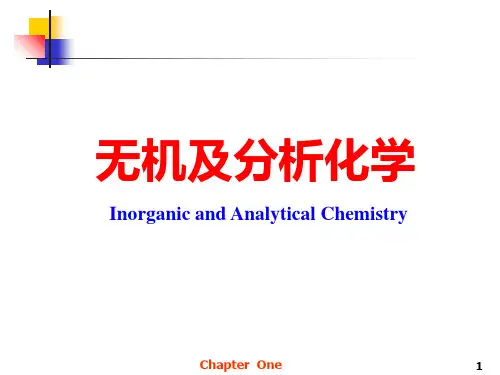
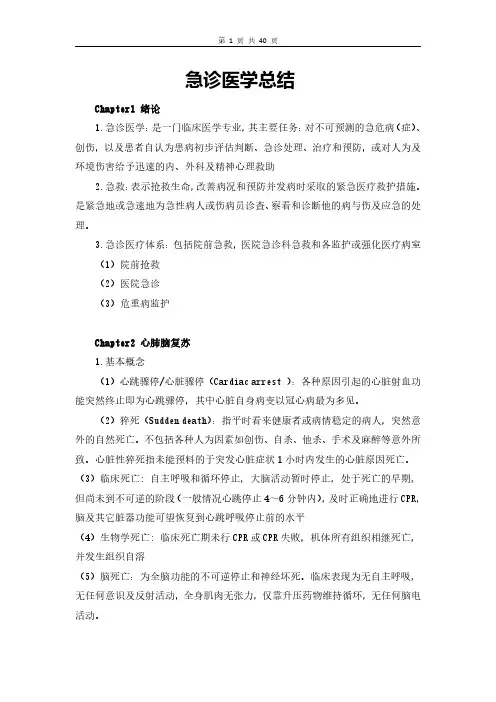
急诊医学总结Chapter1绪论1.急诊医学:是一门临床医学专业,其主要任务:对不可预测的急危病(症)、创伤,以及患者自认为患病初步评估判断、急诊处理、治疗和预防,或对人为及环境伤害给予迅速的内、外科及精神心理救助2.急救:表示抢救生命,改善病况和预防并发病时采取的紧急医疗救护措施。
是紧急地或急速地为急性病人或伤病员诊查、察看和诊断他的病与伤及应急的处理。
3.急诊医疗体系:包括院前急救,医院急诊科急救和各监护或强化医疗病室(1)院前抢救(2)医院急诊(3)危重病监护Chapter2心肺脑复苏1.基本概念(1)心跳骤停/心脏骤停(Cardiac arrest):各种原因引起的心脏射血功能突然终止即为心跳骤停,其中心脏自身病变以冠心病最为多见。
(2)猝死(Sudden death):指平时看来健康者或病情稳定的病人,突然意外的自然死亡。
不包括各种人为因素如创伤、自杀、他杀、手术及麻醉等意外所致。
心脏性猝死指未能预料的于突发心脏症状1小时内发生的心脏原因死亡。
(3)临床死亡:自主呼吸和循环停止,大脑活动暂时停止,处于死亡的早期,但尚未到不可逆的阶段(一般情况心跳停止4~6分钟内),及时正确地进行CPR,脑及其它脏器功能可望恢复到心跳呼吸停止前的水平(4)生物学死亡:临床死亡期未行CPR或CPR失败,机体所有组织相继死亡,并发生组织自溶(5)脑死亡:为全脑功能的不可逆停止和神经坏死。
临床表现为无自主呼吸,无任何意识及反射活动,全身肌肉无张力,仅靠升压药物维持循环,无任何脑电活动。
(6)社会死亡:指CPR成功而脑复苏不完全,处于昏迷状态,脑的某些低级功能和反射活动存在,成为植物人(7)心肺复苏/心肺脑复苏(CPR/CPCR):CPR是指对心脏骤停/猝死的急救过程,是抢救生命最基本的医疗技术和方法。
包括开放气道、人工通气、胸外按压、电除颤纠正VF/VT,及药物治疗等。
又称心肺脑复苏/CPCR (8)心脏骤停的时间:发生心脏骤停的即刻至抢救开始之前的时间为心脏骤停的时间。
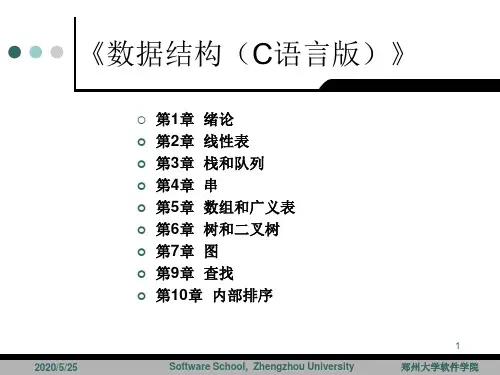

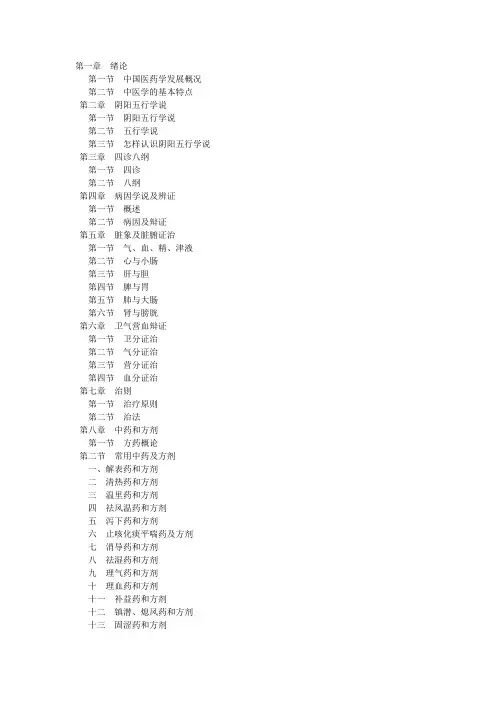
第一章绪论第一节中国医药学发展概况第二节中医学的基本特点第二章阴阳五行学说第一节阴阳五行学说第二节五行学说第三节怎样认识阴阳五行学说第三章四诊八纲第一节四诊第二节八纲第四章病因学说及辨证第一节概述第二节病因及辩证第五章脏象及脏腑证治第一节气、血、精、津液第二节心与小肠第三节肝与胆第四节脾与胃第五节肺与大肠第六节肾与膀胱第六章卫气营血辩证第一节卫分证治第二节气分证治第三节营分证治第四节血分证治第七章治则第一节治疗原则第二节治法第八章中药和方剂第一节方药概论第二节常用中药及方剂一、解表药和方剂二清热药和方剂三温里药和方剂四祛风温药和方剂五泻下药和方剂六止咳化痰平喘药及方剂七消导药和方剂八祛湿药和方剂九理气药和方剂十理血药和方剂十一补益药和方剂十二镇潜、熄风药和方剂十三固涩药和方剂十四开窍药和方剂十五驱虫药和方剂第九章常见病的辩证论治第一节冠心病第二节慢性肝炎第三节溃疡病第四节大叶性肺炎第五节肿瘤第一章绪论第一节中国医药学发展概况一、中国医药学的起源早在远古时代,我们的祖先为了生存和繁衍,在猎取食物的过程中,在同自然灾害、猛兽、疾病作斗争的过程中,已经开始了医疗和保健活动。
例如人们在寻找和识别食物的过程中,误食了一些有毒的药草,在毒性反应过后,却治好了某些病痛,而发明了能治病的药草,这就是传说中的神农尝百草。
我国第一部药物学“神农本草经”,就是后人为了纪念原始社会人们的贡献,托名神农而写的。
在使用石器的过程中,逐步发明了石针来治病,所谓砭石这是针灸疗法的起源。
殷商时期,农业、手工业的生产有了显著的发展,青铜器的广泛应用,促使发明了银针、金针医疗工具。
二、中国医药学的形成约在公元前5-3世纪,即战国时期,直到秦汉时代完成,产生了我国医学最早的一部医书――“内经”。
“内经”包括《灵枢》、《素问》两部书,共18卷,162篇,它总结了秦汉以前的治疗经验和理论知识,它是无数医家共同创造的结晶,是劳动人民在长期生产实践中积累的经验总结。

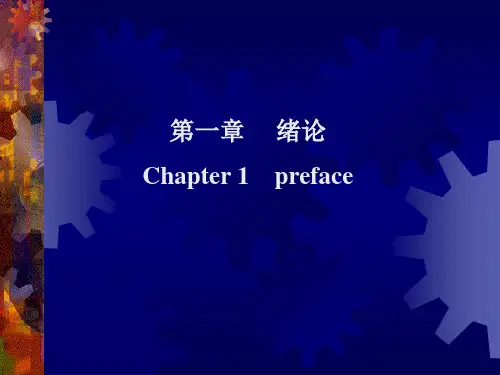
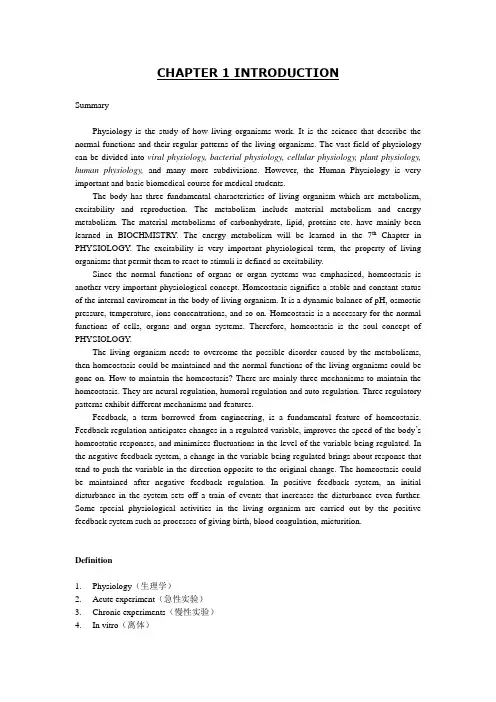
CHAPTER 1 INTRODUCTIONSummaryPhysiology is the study of how living organisms work. It is the science that describe the normal functions and their regular patterns of the living organisms. The vast field of physiology can be divided into viral physiology, bacterial physiology, cellular physiology, plant physiology, human physiology,and many more subdivisions. However, the Human Physiology is very important and basic biomedical course for medical students.The body has three fundamental characteristics of living organism which are metabolism, excitability and reproduction. The metabolism include material metabolism and energy metabolism. The material metabolisms of carbonhydrate, lipid, proteins etc. have mainly been learned in BIOCHMISTRY. The energy metabolism will be learned in the 7th Chapter in PHYSIOLOGY. The excitability is very important physiological term, the property of living organisms that permit them to react to stimuli is defined as excitability.Since the normal functions of organs or organ systems was emphasized, homeostasis is another very important physiological concept. Homeostasis signifies a stable and constant status of the internal enviroment in the body of living organism. It is a dynamic balance of pH, osmostic pressure, temperature, ions concentrations, and so on. Homeostasis is a necessary for the normal functions of cells, organs and organ systems. Therefore, homeostasis is the soul concept of PHYSIOLOGY.The living organism needs to overcome the possible disorder caused by the metabolisms, then homeostasis could be maintained and the normal functions of the living organisms could be gone on. How to maintain the homeostasis? There are mainly three mechanisms to maintain the homeostasis. They are neural regulation, humoral regulation and auto-regulation. Three regulatory patterns exhibit different mechanisms and features.Feedback, a term borrowed from engineering, is a fundamental feature of homeostasis. Feedback regulation anticipates changes in a regulated variable, improves the speed of the body’s homeostatic responses, and minimizes fluctuations in the level of the variable being regulated. In the negative feedback system, a change in the variable being regulated brings about response that tend to push the variable in the direction opposite to the original change. The homeostasis could be maintained after negative feedback regulation. In positive feedback system, an initial disturbance in the system sets off a train of events that increases the disturbance even further. Some special physiological activities in the living organism are carried out by the positive feedback system such as processes of giving birth, blood coagulation, micturition.Definition1.Physiology(生理学)2.Acute experiment(急性实验)3.Chronic experiments(慢性实验)4.In vitro(离体)5.In vivo(在体)6.Metabolism(新陈代谢)7.Interstitial fluid(组织间液)8.Internal environment(内环境)9.Homeostasis(稳态)10.Excitability(兴奋性)11.Excitation(兴奋)12.Inhibition(抑制)13.Stimulus(刺激)14.Neural regulation(神经调节)15.Neuro-humoral regulation(神经体液调节)16.Reflex arc(反射弧)17.Unconditioned reflex(非条件反射)18.Conditioned reflex(条件反射)19.Humoral regulation(体液调节)20.Auto-regulation(自身调节)21.Feedback(反馈)22.Negative feedback(负反馈)23.Positive feedback(正反馈)24.Feedforward(前馈)Choose the ONE best answer, then fill the corresponding letter in the blank.( C ) 1. Which one of the following is a physiological process with negative feedback?A.Blood coagulationB.Process of passing urineC.Sino-aortic baroreceptor reflexD.Na+ influx during action potentialE.Process of parturition( D ) 2. Which one of the following is not the property of regulation by hormone?A.Slow in onsetB.Diffuse in natureC.Longer in durationD.Accurate in actionE.Action in overcorrection( D ) 3. Which of the following is not the fundamental characteristic of living organisms?A.MetabolismB.ExcitabilityC.ReproductionD.Passive diffusionE.Adaption( D ) 4. The concept of homeostasisA.includes the concept of an error signal.B.refers to maintaining physiological functions in a stable condition.C.refers only to the regulation of body temperature.D. A and BE. B and C(A) 5. This term refers to the existence of a stable internal environmentA.HomeostasisB.FeedbackC.AutoregulationD.All the aboveE.None of the above(C) 6. Which one of the following provides long-term regulatory control that results in relatively unchanging internal conditions.A.Positive FeedbackB.DiseaseC.Negative FeedbackD.All the aboveE.None of the above(B) 7. Moving your hand away from a hot stove is an example of a basic function calledA.Positive feedbackB.ResponseC.RegulationD.All the aboveE.None of the above(E) 8. On the objects that Physiology researches and observes, which of the following is correct description ?A.Whole body levelan and organ systems levelsC.Cellular levelD.Molecular levelE.All the above(E) 9. On the methodology applied in Physiology, which of the following is correct?A.Acute experimentB.Chronic experimentC.Experiment in vivoD.Experiment in vitroE.All the above(D) 10. The acceleration of heart beat caused by catecholamine hormones released from adrenal gland after doing exercise, it isA.Neural regulationB.Humoral regulationC.AutoregulationD.Neural-humoral regulationE.None of the aboveQuestions:1.What are the five components of the reflex arc?2.What are fundamental characteristics of living organism?3.Explain the mechanisms of how to maintain the homeostasis in living organism.4.Contrast the properties of the neural regulation, humoral regulation andauto-regulation.5.Describe the category of the humoral regulation.Answers:Definitions:1.Physiology(生理学): Physiology is the study of how living organisms work, the goal ofphysiology is to study the normal functions and their regular patterns of organs or organ systems of living organism.2.Acute experiment(急性实验):Experiment performed is to study the physiological activitiesor to observe the reaction to the external interference in short time is called acute experiment.The animals used are oftenly under anesthesia, and the experiments are oftenly destructive and irreversible, even induce the death of animals. The acute experiment include experiment in vivo and in vitro.3.Chronic experiments(慢性实验): Experiment performed is to study the physiologicalactivities or to observe the reaction to the external interference in long time is called chronic experiment. The Chronic experiments may be performed on conscious subject for a long period of time after recovery from the operation.4.In vitro(离体):Experiment is performed on an isolated tissue or organ that is taken out fromthe body of the animal.5.In vivo(在体):Experiment is performed on the whole body of the animal to observe one orsome physiological functions of the organ or organ systems.6.Metabolism(新陈代谢):Metabolism is the one of basic characteristics of living organism. Itmeans all the chemical reactions in all the cells of the body, and includes all material and energy transformations that occur in the body. The material metabolism includes catabolic and anabolic reactions.7.Interstitial fluid(组织间液):The spaces between cells are called the interstitutium, the fluidin these spaces is the interstitial fluid.8.Internal environment(内环境):It is the environment that all cells of the body live in theextracellular fluid, which is called the internal environment of the body.9.Homeostasis(稳态):The state maintenance of a constancy and balance in one’s internalenvironment. It is the soul of the physiology.10.Excitability(兴奋性):It is the ability of certain kinds of cells (excitable cell) to makeresponse to the stimulus. Essentially, It is the ability of cells to generate action potential.Excitability is a fundamental property to all tissues and cells.11.Excitation(兴奋):It signifies a beginning of an activity or increase in physiological activityafter stimulus, such as the acceleration of the heart beat after stimulating the sympathetic nerve.12.Inhibition(抑制):Inhibition is a stop of an activity or a decrease in physiological activityafter stimulus, such as the slowing of the heart beat after stimulating the vagus nerve.13.Stimulus(刺激):Any changes from external or internal environmental factors that causes aresponse in a sense organ or an organism are called the stimulus. It includes the physical, chemical and biological stimuli.14.Neural regulation(神经调节):The functions of organs or organ systems are regulated by thecentral nervous system via the reflexes. The reflex is the regular response of effectors to the stimulus based on the reflex arc.15.Neuro-humoral regulation(神经体液调节):In many cases, the endocrine system is soclosely related to the nervous system that it can be regarded as an extension of the efferent limb of the reflex arc . In this instance it is called neuro-humoral regulation.16.Reflex arc(反射弧):Reflex arc is the pathway in a reflex, it is the basic unit of integratedneural activity, consisting of receptor, afferent nerve, nervous center, efferent nerve and effector.17.Unconditioned reflex(非条件反射):A fixed reflex whose mechanism may be supposed to beinherited as its functioning does not depend on previous experience.18.Conditioned reflex(条件反射):A learned reflex in which the nervous system is trainedto produce a new and unusual response to a stimulus.19.Humoral regulation(体液调节):The functions of organs or organ systems areregulated by the special chemicals released by the endocrine glands or cells, or metabolic products released by the living cells.20.Auto-regulation(自身调节):In certain cases, a tissue or organ can respond directly to theenvironmental change, depending neither on nervous nor on humoral control. This form of regulation is called auto-regulation.21.Feedback(反馈):It is a flow of information along a closed loop. Usually, a constancy ofphysiological variable requires a feedback mechanism that feeds the output information back to the control system so as to modify the nature of control.22.Negative feedback(负反馈):A regulated variable is sensed, information is sent to acontroller, and action is taken to oppose change from the desire value.23.Positive feedback(正反馈):With a variable is sensed and action is taken to reinforce changeof the variable, so it promotes a change in one direction.24.Feedforward(前馈):control mechanisms often sense a disturbance and can therefore takecorrective action that anticipates changes. Conditioned reflexes belong to the feedforward control system.。